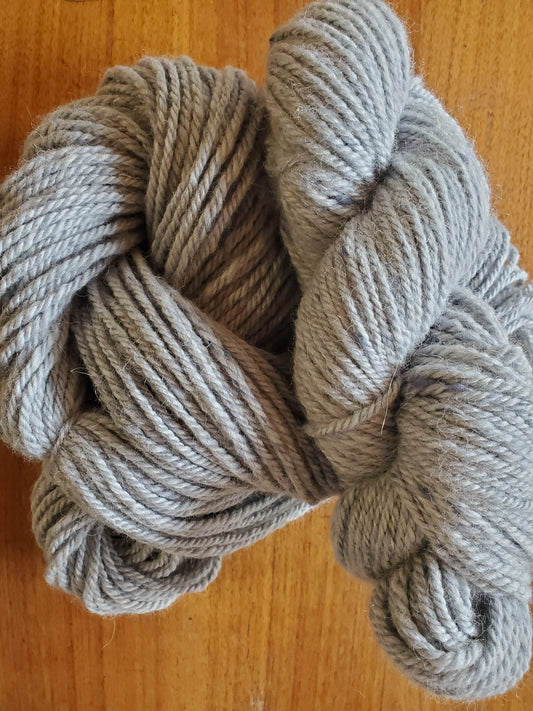About Fibre Processing
In general terms, we take raw, unwashed fibre from sheep, alpaca, llama and other fibre growing animals, and through several steps, convert it into yarn or spinning fibre.
This table goes step by step through the process of turning raw fibre into yarn:
|
STEP |
DESCRIPTION |
|
Tumbling
|
Raw, unwashed fiber is placed in a rotating cage drum, allowing larger particles of dirt to fall out of the fleece prior to washing. |
|
Washing/Scouring
|
Sheeps wool contains lanolin, manure, dirt, and vegetative matter and must be washed in hot water with a scouring agent prior to further processing. We do not offer scouring-only services. Our yarns do not undergo the chemically intensive process of carbonizing to remove vegetable matter that many commercially spun yarns undergo. Read about that here. Even with intensive skirting, there is very likely to be some VM in finished yarns. |
|
Picking |
After scouring, the fiber is thoroughly air dried, and then fed into a picker/opener. The Picker teases out entanglements and opens the fiber to give consistency in further processing. The fiber is thrown into a collection room where conditioning oils may be applied. |
|
Fibre Separator |
Many breeds of sheep are dual coated, with a coarse outer coat and fine, soft inner coat. Most camelids (alpaca, llama) have dual coats and the outer coat is very coarse and should be separated prior to spinning for a higher value product. This machine separates the dual coats, removes all types of contamination and opens fibre for further processing. As noted above, we do not use 'carbonizing' to remove VM. The fibre separator is our main tool for removing VM. This is an optional step in processing fibre, but highly recommended to improve the final product. |
|
Carding |
The carder is the heart of a fibre mill. It separates randomly placed fibres from each other and individually aligns these fibres, presenting them in the form of a continuous web at the output end. This web can be turned into batts or roving. |
|
Draw Frame |
The function of the draw frame is to take rovings from the Carder and blend them together into one fibre stream to improve consistency. You can make the roving bigger or smaller at this stage. |
|
Spinning |
The Belfast Mini Mill Spinners draw in rovings or slivers and direct them through a controlled drafting system, outputting an extremely consistent fibre stream. This fibre stream is then twisted into a finished single of yarn and stored on bobbins. Our mill has an 8 spindle spinner and a 4 spindle plyer. |
|
Steaming |
During the steaming process the plied yarn is drawn through the steamer by the Cone Winder. While under slight tension the yarn is pulled through a steam chamber and then a drying tube. This process sets the twist. Any tensions that are placed into the yarn during the spinning or plying processes are evened out during steaming. |
|
Skein Winding |
The skein winder produces a two-yard or a one and a half yard skein. Yarn processed by the skein winder is metered and wound into skeins. |
There is some weight lost in all fibre processing. See the table for some average yields for different sheep breeds. Keep in mind, fleeces with high levels of vegetative matter, matting, etc, will yield less.
Common ranges of fiber diameter, grease fleece weight, and clean wool yield for various sheep breeds.*
| Breed | Range of Average Fiber Diameter (µm) |
Range of Grease Fleece Weight (lb) |
Range of Clean Wool Yield (%) |
| Border Leicester | 38-30 | 8-12 | 60-70 |
| Cheviot | 33-27 | 5-8 | 50-65 |
| Columbia | 30-23 | 9-14 | 45-60 |
| Cormo | 22-19 | 10-14 | 60-70 |
| Corriedale | 31-24 | 9-14 | 45-60 |
| Debouillet | 23-18 | 9-14 | 45-55 |
| Delaine-Merino | 22-17 | 9-14 | 40-50 |
| Dorset | 32-26 | 5-8 | 50-65 |
| Finnsheep | 31-24 | 4-8 | 50-70 |
| Hampshire | 33-25 | 6-10 | 50-60 |
| Lincoln | 41-34 | 10-14 | 55-70 |
| Merino (superfine) | <18 | 6-9 | 60-70 |
| Merino (fine) | 19-20 | 6-11 | 60-70 |
| Merino (medium) | 21-22 | 9-13 | 65-75 |
| Merino (strong) | 23-26 | 11-15 | 65-75 |
| Montadale | 30-25 | 7-11 | 50-60 |
| Oxford | 34-28 | 7-10 | 50-60 |
| Rambouillet | 23-19 | 9-14 | 45-60 |
| Romney | 39-32 | 8-12 | 55-70 |
| Shropshire | 33-25 | 6-10 | 50-60 |
| Southdown | 29-24 | 5-8 | 40-55 |
| Suffolk | 33-26 | 4-8 | 50-60 |
| Targhee | 25-21 | 9-14 | 45-60 |
| Texel | 33-28 | 7-10 | 60-70 |
| *Primary source: Sheep Production Handbook. 1996. American Sheep Industry Association Inc. Production, Education, and Research Council. | |||
Online Store
Check out what's available in our online store!
-
100% Wool - Lopi (Heavy Worsted)
Regular price From $27.62 CADRegular price -
100% Alpaca - 2 ply - Sport
Regular price $35.24 CADRegular price -
A bit of everything - Romney/alpaca/rambouillet/silk
Regular price $35.24 CADRegular price -
80% Alpaca 20% Merino bulky 3 ply
Regular price $37.14 CADRegular price




